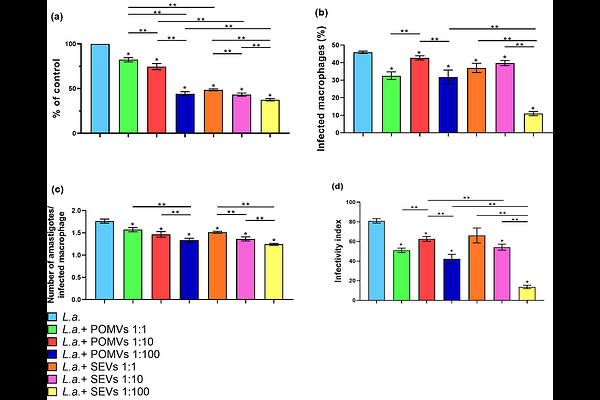Impact of Bacterial Membrane Vesicles on Cellular Responses in Leishmania amazonensis-Infected Macrophages In Vitro

Impact of Bacterial Membrane Vesicles on Cellular Responses in Leishmania amazonensis-Infected Macrophages In Vitro
Francisco, P. H. G.; Jorge, G. P.; Roque, G. A. S.; e Silva, M. F.; da Silva, N. S.; Fagundes, C. C.; Oliveira, A. L. R.; Almeida, F. B.; Brocchi, M.; Giorgio, S.
AbstractLeishmania amazonensis is an intracellular protozoan parasite and the main cause of Localized Cutaneous Leishmaniasis (LCL). A practical problem that can worsen the condition of infected individuals is secondary co-infection caused by opportunistic bacteria. This study evaluated the influence of Bacterial Membrane Vesicles (BMVs) from Pseudomonas aeruginosa and Staphylococcus aureus, both commonly associated with LCL, on macrophages previously infected with L. amazonensis. The diameter and concentration of BMVs were consistent with previous findings. We assessed infection dynamics, macrophage viability, and cytokine production. Results showed significant reductions in these parameters when L. amazonensis-infected macrophages were subsequently treated with BMVs, compared to the control group (infected but not treated with BMVs). Quantification of IL-2, IL-4, IL-6, IL-10, IL-17A, IFN-gamma;, and TNF-alpha; revealed elevated levels of the last cytokine, suggesting an inflammatory response. Co-cultures treated with BMVs from P. aeruginosa (POMVs) exhibited a more pronounced inflammatory profile, marked by higher IL-1beta; and TNF-alpha; concentrations, compared to those treated with BMVs from S. aureus (SEVs). IL-4 and IL-6 levels remained low relative to IL-1beta; and TNF-alpha;. In conclusion, our data suggest that macrophage infection with L. amazonensis followed by exposure to bacterial MVs simulates a host-parasite-bacterial interaction, inducing strong immunogenic and inflammatory responses, which may represent potential targets for future vaccine strategies.